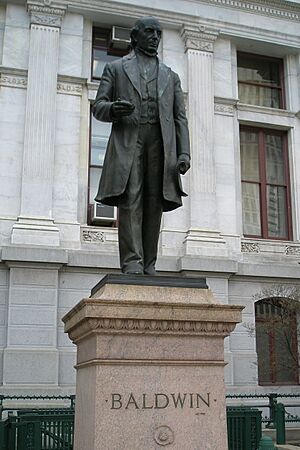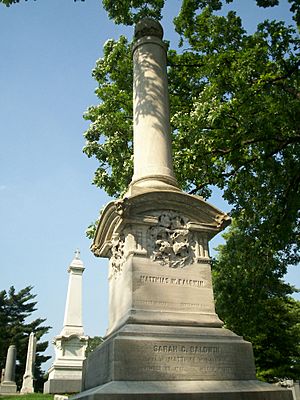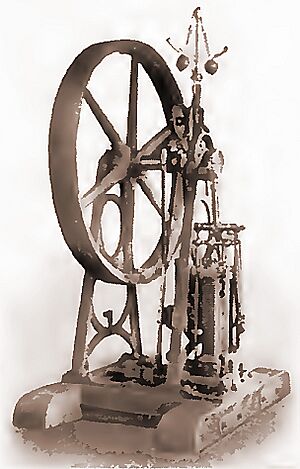Matthias W. Baldwin facts for kids
Quick facts for kids
Matthias W. Baldwin
|
|
|---|---|
 |
|
| Born | December 10, 1795 |
| Died | September 7, 1866 (aged 70) Philadelphia, Pennsylvania, US
|
| Occupation | Inventor, machinery manufacturer |
Matthias William Baldwin (born December 10, 1795 – died September 7, 1866) was an American inventor. He was also a famous manufacturer of machines, especially steam locomotives. Baldwin started a small machine shop in 1825. This shop grew into Baldwin Locomotive Works, which became one of the biggest and most successful locomotive companies in the United States. One of his most famous early locomotives was Old Ironsides, built in 1832. Baldwin also strongly supported the movement to end slavery.
Contents
Matthias Baldwin's Early Life
Matthias W. Baldwin was born on December 10, 1795, in Elizabethtown, New Jersey. He was the youngest of five children. His father, William Baldwin, built carriages and was quite successful. However, after his father died in 1799, Matthias's family faced money problems because of poor management of the family's finances.
Even though he had a good school education, Matthias loved to tinker with machines from a young age. He would take apart toys to see how they worked. He also used spare machine parts to build new things in a small workshop at his mother's home.
In 1811, when he was 16, Baldwin became an apprentice jewelry maker. He worked for the Woolworth Brothers in Frankford, Pennsylvania (now part of Philadelphia). Being an apprentice meant working long hours for very little pay. In 1817, Baldwin moved with his mother to Philadelphia. There, he worked for Fletcher & Gardner, a top jewelry company.
Baldwin was a very good worker. In 1819, he left Fletcher & Gardner to start his own business as a silversmith. He quickly became known as a skilled and creative craftsman. He even invented a new way to make gold plate. Instead of carefully applying thin sheets of gold, Baldwin's method involved soldering a piece of gold to a cheaper metal. Then, he would roll them together until they were the right thickness. This new method became very popular in the industry. Unfortunately for Baldwin, he never got a patent for his invention.
Becoming a Machinery Maker
In the mid-1820s, the demand for jewelry and silverware dropped a lot. This made Baldwin look for a new type of work. In 1825, he teamed up with a machinist named David Mason. They started a company that made industrial equipment for printers and bookbinders. These were tools, dies, and machines that used to be imported only from Europe. They also started making printing cylinders and improved how steel plates were etched.
Their growing company needed a bigger space and a better power source. In 1828, Baldwin designed and built his first steam engine. This was a stationary engine, meaning it stayed in one place. It produced 5 horsepower and was used in his shop for 40 years! Baldwin's engine was very powerful for its time. It also had new mechanical ideas that helped power spinning motion. These ideas were later used in transport, including ship engines. The original engine is still kept at the Smithsonian Institution in Washington, D.C.
There was a big demand for steam engines. So, Baldwin and Mason soon focused more on making engines than printing machinery. Within ten years, their company was known as the best engine maker in the country.
Building Locomotives
Baldwin used his knowledge of steam engines to build his first experimental steam locomotive in 1831. He based his design on engines seen at the Rainhill Trials in England. Baldwin's first locomotive was a small demonstration engine. It was shown at Peale's Philadelphia City Museum. This engine was strong enough to pull a few cars, each carrying four passengers. It was special because it burned coal, which was found nearby, instead of wood.
The next year, Baldwin built his first locomotive for a customer. It was for the new Philadelphia, Germantown & Norristown Railroad. This engine was nicknamed Old Ironsides. In its first tests on November 23, 1832, it only went about 1 mile per hour (1.6 km/h). But Baldwin improved it, and it later reached a top speed of 28 mph (45 km/h). It weighed over 5 tons. It had large rear wheels and a boiler that took 20 minutes to build up steam. This locomotive was a 2-2-0 type. This means it had one set of unpowered wheels at the front and one set of powered wheels that drove the train. The railroad agreed to pay $4,000 for it. But because of some early problems, they settled on a price of $3,500. This was the start of the Baldwin Locomotive Works.
In 1836, Baldwin received a patent for his new way of managing fire in locomotive engines. This invention allowed train workers to quickly swap out a used firebox for a fresh, clear coal fire at each station. This made the engines run more efficiently.
Matthias Baldwin's Personal Life

Baldwin was a very religious man and a member of the Presbyterian Church. He often gave money to religious and charity causes throughout his life. In 1824, he helped start the Franklin Institute in Philadelphia, which is a science museum and education center. He also became a member of the American Philosophical Society in 1833.
In 1835, he gave money to open a school for African-American children in Philadelphia. He even paid the teachers' salaries himself for many years. Baldwin was a strong supporter of ending slavery. This position was sometimes used against him by other companies. They would try to sell locomotives to railroads in the South by saying Baldwin supported abolition.
Baldwin was also part of the 1837 Pennsylvania Constitutional Convention. Here, he spoke up for the voting rights of black men in the state.
Baldwin married his distant cousin, Sarah C. Baldwin, in 1827. They had three children together.
One of his last acts of kindness was donating 10% of his company's earnings to the Civil War Christian Mission in the early 1860s.
Death and Legacy

Matthias Baldwin died on September 7, 1866, at his home in Wissinoming. He was buried at Laurel Hill Cemetery in Philadelphia.
When Baldwin died, his company, Baldwin Locomotive Works, had built about 1,500 steam locomotives. The company continued to grow and eventually produced around 75,000 steam locomotive engines before it stopped making them in 1956.
A statue of Baldwin was first put up in Philadelphia in 1906. It was moved in front of Philadelphia City Hall in 1936. In May 2020, someone briefly wrote on it, but it was cleaned quickly. This event made more people interested in learning about Baldwin's important contributions.
See also
 In Spanish: Matthias W. Baldwin para niños
In Spanish: Matthias W. Baldwin para niños
- Baldwin Locomotive Works



